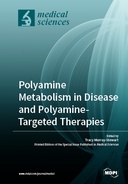Explore

Polyamine Metabolism in Disease and Polyamine-Targeted Therapies
Tracy Murray-Stewart
2019
0 Ungluers have
Faved this Work
Login to Fave
Polyamines are ubiquitous polycations essential for all cellular life. The most common polyamines in eukaryotes, spermine, spermidine, and putrescine, exist in millimolar intracellular concentrations that are tightly regulated through biosynthesis, catabolism, and transport. Polyamines interact with, and regulate, negatively charged macromolecules, including nucleic acids, proteins, and ion channels. Accordingly, alterations in polyamine metabolism affect cellular proliferation and survival through changes in gene expression and transcription, translation, autophagy, oxidative stress, and apoptosis. Dysregulation of these multifaceted polyamine functions contribute to multiple disease processes, thus their metabolism and function have been targeted for preventive or therapeutic intervention. The correlation between elevated polyamine levels and cancer is well established, and ornithine decarboxylase, the rate-limiting biosynthetic enzyme in the production of putrescine, is a bona fide transcriptional target of the Myc oncogene. Furthermore, induced polyamine catabolism contributes to carcinogenesis that is associated with certain forms of chronic infection and/or inflammation through the production of reactive oxygen species. These and other characteristics specific to cancer cells have led to the development of polyamine-based agents and inhibitors aimed at exploiting the polyamine metabolic pathway for chemotherapeutic and chemopreventive benefit. In addition to cancer, polyamines are involved in the pathologies of neurodegenerative diseases including Alzheimer’s and Parkinson’s, parasitic and infectious diseases, wound healing, ischemia/reperfusion injuries, and certain age-related conditions, as polyamines are known to decrease with age. As in cancer, polyamine-based therapies for these conditions are an area of active investigation. With recent advances in immunotherapy, interest has increased regarding polyamine-associated modulation of immune responses, as well as potential immunoregulation of polyamine metabolism, the results of which could have relevance to multiple disease processes. The goal of this Special Issue of Medical Sciences is to present the most recent advances in polyamine research as it relates to health, disease, and/or therapy.
This book is included in DOAB.
Why read this book? Have your say.
You must be logged in to comment.
Rights Information
Are you the author or publisher of this work? If so, you can claim it as yours by registering as an Unglue.it rights holder.Downloads
This work has been downloaded 284 times via unglue.it ebook links.
- 92 - pdf (CC BY-NC-ND) at Unglue.it.
Keywords
- ?-difluoromethylornithine
- African sleeping sickness
- Aging
- airway smooth muscle cells
- antizyme
- antizyme 1
- antizyme inhibitors
- Atrophy
- Autoimmunity
- Autophagy
- B-lymphocytes
- Biology, Life Sciences
- bis(ethyl)polyamine analogs
- Breast cancer
- cadaverine
- Cancer
- capsule
- carcinogenesis
- Cell Differentiation
- chemoprevention
- colorectal cancer
- complementation
- CRISPR
- curcumin
- DFMO
- diferuloylmethane
- difluoromethylornithine
- difluoromethylorthinine
- Drosophila imaginal discs
- eflornithine
- Eosinophils
- epigenetics
- hirsutism
- human embryonic kidney 293 (HEK293)
- Immunity
- M2 macrophages
- mast cells
- Mathematics & science
- MCF-7 cells
- Melanoma
- Metabolism
- mutant BRAF
- MYC
- Neuroblastoma
- Neutrophils
- NF-?B
- ornithine decarboxylase
- Osteosarcoma
- Oxidative Stress
- pancreatic ductal adenocarcinoma
- pneumococcal pneumonia
- Polyamine
- polyamine analogs
- polyamine metabolism
- polyamine transport
- polyamine transport inhibitor
- polyamine transport system
- Polyamines
- polyphenol
- protein expression
- protein synthesis in cancer
- Proteomics
- Putrescine
- skeletal muscle
- Snyder-Robinson Syndrome
- Spermidine
- spermidine/spermine N1-acetyl transferase
- Spermine
- spermine oxidase
- spermine synthase
- Streptococcus pneumoniae
- T-Lymphocytes
- thema EDItEUR::P Mathematics and Science::PS Biology, life sciences
- transgenic mice
- transgenic mouse
- Transglutaminase
- tumor immunity
- untranslated region
- X-linked intellectual disability
Links
DOI: 10.3390/books978-3-03921-153-1Editions


